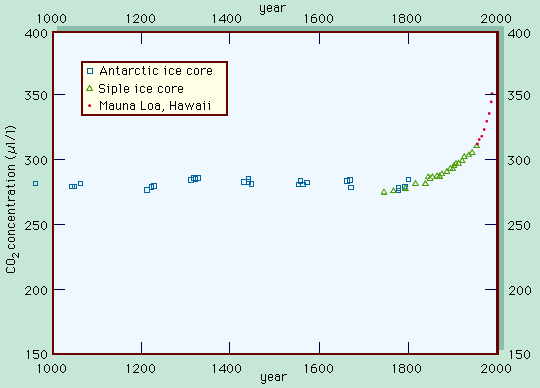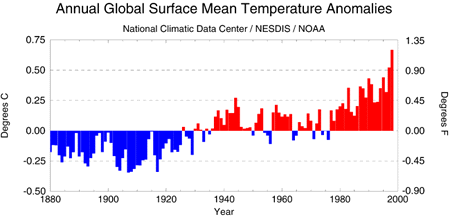
The greenhouse effect is a warming of the Earth's surface and lower atmosphere that tends to intensify with an increase in atmospheric carbon dioxide.

The atmosphere allows a large percentage of the rays of visible light from the Sun to reach the Earth's surface and heat it. A part of this energy is reradiated by the Earth's surface in the form of long-wave infrared radiation, much of which is absorbed by molecules of carbon dioxide and water vapour in the atmosphere and which is reflected back to the surface as heat. This is roughly analogous to the effect produced by the glass panes of a greenhouse, which transmit sunlight in the visible range but hold in heat.

The trapping of this infrared radiation causes the Earth's surface and lower atmospheric layers to warm to a higher temperature than would otherwise be the case. Without this greenhouse heating, the Earth's average temperature would be only about -73 C (-100 F); even the oceans would be frozen under such conditions. Alternatively, a "runaway" greenhouse effect like that found on the planet Venus would result in surface temperatures as high as 500 C (932 F).
Owing to the rise in atmospheric carbon dioxide caused by modern industrial societies' widespread combustion of fossil fuels (coal, oil, and natural gas), the greenhouse effect on Earth may be intensified and long-term climatic changes may result. An increase in atmospheric concentrations of other trace gases such as chlorofluorocarbons (Freons), nitrous oxide, and methane, due again largely to human activity, may also aggravate greenhouse conditions. A growing number of scientists have predicted that significant alterations in climate patterns will be seen by the turn of the century. They estimate that global average temperatures could increase by as much as 5 C (9 F) by the middle of the 21st century. Such global warming would cause the polar ice caps and mountain glaciers to melt rapidly and result in appreciably higher coastal waters. The rise in global temperature would also produce new patterns and extremes of drought and rainfall, seriously disrupting food production in certain regions. Other scientists involved in climatic research maintain that such predictions are overstated, however.


Excerpt from the Encyclopedia Britannica without permission.